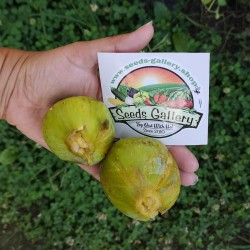Menu
-
MenuInapoi
- Home
-
Categorii
-
-
Categorii
-
Semințe de legume
-
Soiuri după țară
- Soiuri din Armenia
- Soiuri din BiH
- Soiuri din Croația
- Soiuri din Franța
- Varieties from Germany
- Varieties from Greece
- Varieties from Hungary
- Soiuri din India
- Varieties from Italy
- Soiuri din Japonia
- Soiuri din Macedonia de Nord
- Varieties from Peru
- Varieties from Russia
- Varieties from Serbia
- Soiuri din Slovenia
- Varieties from Spain
- Varieties from Thailand
- Soiuri din Turcia
- Varieties from USA
- Semințe de roșii
- Semințe de porumb
- Familia Dovleac
- Familia Bean
- Semințe de castraveți
- Seminte de ardei gras
- Familia morcovului
- Familia ceapa
- Semințe de salată verde
- Familia cartofilor
- Familia de varză
- Semințe de ridiche
- Familia sfeclei
- Semințe de pepene verde
- Semințe de pepene galben
- Semințe de conopidă
- Familia de floarea soarelui
-
Soiuri după țară
- Semințe de fructe
- Seminte de Chili Peppers
- Semințe de plante medicinale
- Semințe de plante cățărătoare
- Copaci - Arbust - Semințe
- Semințe de palmier
- Semințe de ierburi ornamentale
- Semințe de tutun
-
Semințe de legume
-
-
-
-
- PRODUSE NOI
- Crează un cont
- Livrare - Plata
- FAQ
- Soiuri după țară
-
- Soiuri din Armenia
- Soiuri din BiH
- Soiuri din Croația
- Soiuri din Franța
- Varieties from Germany
- Varieties from Greece
- Varieties from Hungary
- Soiuri din India
- Varieties from Italy
- Soiuri din Japonia
- Soiuri din Macedonia de Nord
- Varieties from Peru
- Varieties from Russia
- Varieties from Serbia
- Soiuri din Slovenia
- Varieties from Spain
- Varieties from Thailand
- Soiuri din Turcia
- Varieties from USA
Last Product Reviews
Out of the two seeds, one germinated and the other one was dead and floatin...
By
 Riikka H on 07/03/2024
Riikka H on 07/03/2024
Verified Purchase
Sunt 439 produse.
Se afiseaza 406-420 din 439 produs(e)

Varietate din Japonia
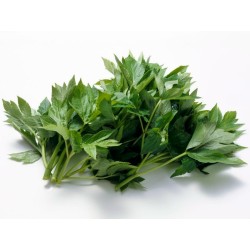
Ashitaba seeds (Tomorrow's...
Pret
3,95 €
(SKU: MHS 100)
Seeds Gallery EU,
5/
5
<h2><strong>Ashitaba seeds (Tomorrow's Leaf) (Angelica keiskei)</strong></h2>
<h2><span style="color: #ff0000;"><strong>Price for Package of 5 seeds.</strong></span></h2>
<p><span>Angelica keiskei Koidzumi, commonly known under the Japanese name of Ashitaba (アシタバ or 明日葉 ashitaba, literally "Tomorrow's Leaf"), is a cold hardy perennial plant from the angelica genus with an average growth height of 50–120 cm. It is endemic to Hachijō-jima, though it is artificially cultivated in Izu Ōshima, Mikura-jima, Nii-jima, To-shima and parts of Honshū as well.</span></p>
<p><span>The plant's additional cultivar epithet koidzumi refers to botanist Gen'ichi Koizumi, while its Japanese nomenclature stems from the above-average regenerative capabilities it exhibits after injury. Harvesting a leaf at the break of day often results in a new sprout growing overnight, being visible the following morning.</span></p>
<p><span>Traditionally it is seen as a major contributor to the supposedly healthier, extended lives of the local residents, possibly due to the chalconoids that are unique to this species of angelica. At one point in Edo period, the haulm's yellow sap was effectively used in the external treatment of smallpox, which prompted Kaibara Ekken to describe the herb in his Yamato honzō (大和本草), under the name of ashitagusa (鹹草), as "a powerful tonic drug." In folk medicine it is claimed to be diuretic, tonic, to improve digestion, and, when applied topically, to speed wound healing and prevent infection. Also, its nutritive qualities are said to be the factor behind the internal exiles' and their families' never waning stamina in the face of their arduous compulsory labor.</span></p>
<p><span>For similar reasons, it very widely serves as pasture for cows, reckoned to improve the quality of milk as well as the yield and to maintain cattle health at the same time. It should be pointed out that most of these claims have yet to be proven in clinical trials, while studies have substantiated the presence of furocoumarins in several of these plants' components. Furanocumarin is an agent known to increase skin sensitivity to sunlight and may cause dermatitis.</span></p>
<p><span>Nonetheless, modest conditions for cultivation and fast rate of growth, with optimal temperatures ranging between 12-22 degrees, have led many locals to plant ashitaba in herb gardens, flower pots, and backyards. These days the main use of their stipes, leaves, and taproots is in regional cuisine, where they are prepared as soba, tempura, shōchū, tea, ice cream, pasta etc. The Mikura-jima variety might excel in this regard as it is reputed to be less bitter than others.</span></p>
<p><span>Note that ashitaba closely resembles Angelica japonica, but can be distinguished by its blooming period, which lasts from May to October whereas A. japonica's blooming period lasts only between May and July. Another indicator is the characteristic color of its sap.[2] The larvae of the Common Yellow Swallowtail are known to feed frequently on the plant.</span></p>
<h2><span>Medicinal properties</span></h2>
<p><span>A. keiskei has been claimed to exhibit cytotoxic, antidiabetic, antioxidative, anti-inflammatory, antihypertensive, and antimicrobial properties via in vitro studies, but the efficacy of these qualities have yet to be confirmed in vivo.[3] Among current investigations is its potential as a nerve growth factor,[4] as well as potential usefulness in cancer, menopause, and other conditions.[5] Ashitaba may have positive effects on circulation by preventing red blood cells from clumping.</span></p>
<h2><strong><span>Claims of being a vegetable source of vitamin B12</span></strong></h2>
<p><span>Although it is often suggested that A. keiskei is a vegetable source of vitamin B12 (cyanocobalamin), recently published, peer-reviewed scientific investigations of pharmacology and phytochemical constituents of interest report nothing that substantiates this claim.[7][8] Traditional methods for measuring vitamin B12 in foods are compromised by contaminants (e.g. soil, bacteria, etc.) that contain detectable concentrations of inactive B12 analogs, which may explain the origin of this belief.[9] More recent studies reveal certain mushrooms and algae as the only naturally occurring sources of B12 outside of the animal kingdom.[10] Of these, only Chlorella has demonstrated the ability to reduce methyl malonic acid (MMA) levels (a product of B12 deficiency) in human subjects.</span></p>
<p><strong><span>Soak seeds overnight in cool, non-chlorinated water and then refrigerate the seeds (approximately 40 degrees F) in the moist medium for 3 days. </span></strong></p>
<p><strong><span>The moist medium could be moist sand, moist potting soil, moist coir or moist peat. </span></strong></p>
<p><strong><span>Note that our recommendation is MOIST, not SODDEN or VERY WET and that we are recommending REFRIGERATION not FREEZING. </span></strong></p>
<p><strong><span>After this pretreatment, plant the (still moist) seeds. </span></strong></p>
<p><strong><span>Sow on surface, barely cover with soil and press in firmly and keep evenly moist until germination. </span></strong></p>
<p><strong><span>Use a greenhouse, shade house or grow lights. </span></strong></p>
<p><strong><span>Germination Temperature is around 20C/68F</span></strong></p>
<p><strong><span>Germination occurs 30 to 60 days after sowing. </span></strong></p>
<p><strong><span>Seedlings are slow-growing and will require about 60 days to transplant. </span></strong></p>
<p><strong><span>Once past the seedling stage, the plant is fast growing. </span></strong></p>
<p><strong><span>The plants prefer rich, deep, ever moist, well-drained soil and full sun to part shade. </span></strong></p>
<p><strong>Water every other day.</strong></p>
MHS 100 (5 S)


Varietate din Serbia
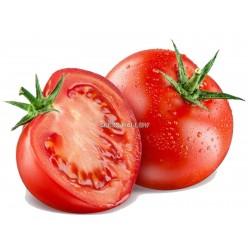
5000 Seeds Novosadski...
Pret
22,00 €
(SKU: VT 130 (25g))
Seeds Gallery EU,
5/
5
<h2 class="">5000 Seeds Novosadski Jabucar Tomato</h2>
<h2><span style="color: #ff0000; font-size: 14pt;"><strong>Price for Package of 5000 seeds (25g).</strong></span></h2>
<div>70-80 days, Medium early variety, Indeterminate. The fruits are round, smooth, bright red, average weight is 130-150 g. He has a good ratio of total sugar and acid, with a dry matter content of 6 to 6.5% and a very good taste. It can be grown from seeds, and without support.</div>
<div>History:</div>
<div>Old tested variety from Serbia. 'Jabucar' means 'Apple' in Serbian.</div><script src="//cdn.public.n1ed.com/G3OMDFLT/widgets.js"></script>
VT 130 (25g)


Varietate din Serbia
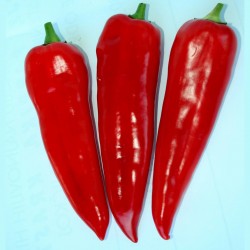
Kurtovska Kapija Sweet...
Pret
1,95 €
(SKU: PP 39)
Seeds Gallery EU,
5/
5
<h2 class=""><strong>Kurtovska Kapija Sweet Pepper Seeds (Kurt's Gate)</strong></h2>
<h2><span style="color: #ff0000;" class=""><strong>Price for Package of 50 seeds.</strong></span></h2>
<div>The Kurtovska kapija sweet pepper (Kurt's Gate) is a favorite variety in Serbia when it comes to winter food preservation, especially for making <span style="color: #ff0000;"><a href="https://en.wikipedia.org/wiki/Ajvar" target="_blank" title=""Ajvar"" style="color: #ff0000;" rel="noreferrer noopener"><strong>"Ajvar"</strong></a></span>. The fruit is sweet, weighs 150 to 300 grams, large, thick pericarp in the technologically mature dark green, and in biologically intense red. </div>
<div></div>
<div>The Plant: strong, compact, tall, hanging fruits. </div>
<div>Kurt's Gate Pepper is a late variety.</div>
<div></div>
<div>Yields range up to 30 t / ha</div>
<script src="//cdn.public.n1ed.com/G3OMDFLT/widgets.js"></script>
PP 39 (50 S)


Varietate din Serbia
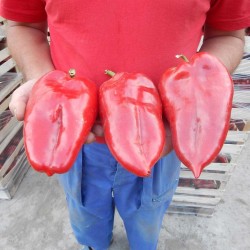
Seminte de ardei dulci...
Pret
2,15 €
(SKU: PP 56)
Seeds Gallery EU,
5/
5
<h2><strong>Seminte de ardei dulci urechi de elefant</strong></h2>
<h2><span style="color: #ff0000;" class=""><strong>Prețul este pentru pachetul de 50 semințe.</strong></span></h2>
<p>Fructat mare, aromat. Urechea de elefant este una dintre soiurile sârbești preferate din Serbia, este folosită mai ales pentru a face „ajvar”, „pinđur”, pentru umplutură și pentru congelare. Pot fi folosite bine pentru decapare, pentru grătar, în preparate cu legume, în preparate din carne și ca salată.</p>
<p>Excelent în gust.</p>
<p>Urechea de elefant este ardeiul dulce, cu fructe foarte mari și cărnoase. Culoarea fructului se schimbă de la verde închis la roșu aprins când este coaptă. Atinge o greutate de 150-350gr. Este foarte rezistent la boli și oferă un randament stabil de 50/60 tone pe acru. Acest soi este potrivit pentru seră, pentru rame reci și, de asemenea, pentru exterior.</p>
<script src="//cdn.public.n1ed.com/G3OMDFLT/widgets.js"></script>
PP 56 (50 S)


Varietate din Serbia
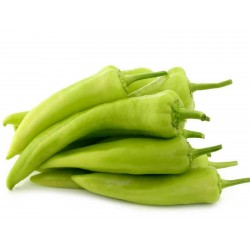
Sweet Pepper Seeds ECSTASY
Pret
2,45 €
(SKU: PP 57)
Seeds Gallery EU,
5/
5
<h2><strong>Sweet Pepper Seeds ECSTASY</strong></h2>
<h2><span style="color: #ff0000;"><strong>Price for Package of 20 seeds.</strong></span></h2>
<p>ECSTASY is a very early variety from Serbia with long fruits intended for cultivation in greenhouses and in the open field. The fruits reach a length of 25-30 cm. The fruits are sweet and delicious. In the greenhouse, the plants grow up to 170 cm in height.</p>
<p><strong>Fruit Weight:</strong> 130 g</p>
<p><strong>Fruit length:</strong> 25-30 cm.</p>
<p><strong>Serbian Variety</strong></p>
PP 57 (20 S)


Varietate din Serbia
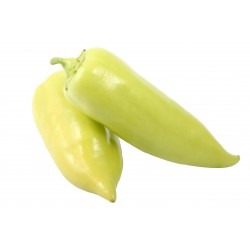
Sweet pepper seeds ROMANCE...
Pret
1,95 €
(SKU: PP 34)
Seeds Gallery EU,
5/
5
<h2><strong>Sweet pepper seeds ROMANCE - Variety from Serbia</strong></h2>
<h2><span style="color: #ff0000;"><strong>Price is for pack of 20 seeds.</strong></span></h2>
<p>Romance is an early variety from Serbia, long, large and meaty, for cultivation in a protected area and open field. Young fruits are light green to yellow and ripe red. They are conical, sweet, reaching a length of 25-30 cm, a width of 6-7 cm and weighing 250 g per fruit.</p>
<p>Romance has an excellent sweet aroma.</p>
PP 34 (20 S)


Varietate din Serbia
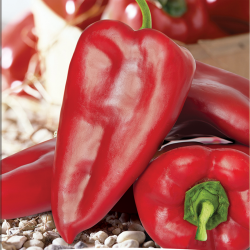
Seminte mari de ardei dulce...
Pret
1,75 €
(SKU: PP 61)
Seeds Gallery EU,
5/
5
<h2><strong>Seminte mari de ardei dulce Supernova</strong></h2>
<h2><span style="color: #ff0000;"><strong>Pret pentru un pachet de 50 de seminte.</strong></span></h2>
<p>Ardeii Supernova au fructe mari care se schimbă de la verde la roșu în timpul coacerii. Fructele sunt mari, cântărind până la 300 de grame, foarte dulci.</p>
<p>Acest soi s-a dovedit a fi excelent atât pentru coacere, cât și pentru depozitarea pe timp de iarnă. Este potrivit pentru congelare și utilizare ulterioară.</p>
<p>În ceea ce privește cultivarea în sine, a demonstrat că reușește atât în câmp deschis, cât și în seră.</p>
<p>Planta este puternică și rezistentă la multe boli care atacă ardeii.</p>
PP 61 (50 S)


Varietate din Serbia
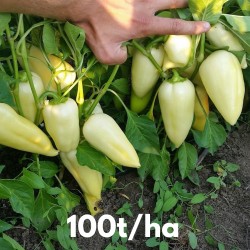
Seminte de ardei dulce Amanda
Pret
2,15 €
(SKU: PP 62)
Seeds Gallery EU,
5/
5
<h2><strong>Seminte de ardei dulce Amanda</strong></h2>
<h2><span style="color: #ff0000;"><strong>Preț pentru un pachet de 50 semințe.</strong></span></h2>
<p>Amanda este o varietate cu carne groasă și vârful ascuțit. Aparține soiului de ardei alb și este excelent pentru cultivarea în seră, precum și în aer liber, dar randamentul în seră poate fi de două ori mai mare.</p>
<p>Planta este compactă, puternică, cu frunze mari. Fructul are pulpa groasă, crocantă și foarte suculentă, este unul dintre ardeii dulci. Fructele atârnă pe plantă, cântărind 120 până la 160 de grame. Este excelent pentru murături și prăjit, precum și pentru consum proaspăt.</p>
<p>Soiul este foarte productiv și are o formă foarte frumoasă, în seră poate da până la 2 kg per plantă cu grijă și nutriție bună. Fructul este mai întâi alb și apoi devine treptat galben și devine roșu. Semințele acestui soi pot fi îndepărtate și lăsate pentru reproducere ani de zile.</p>
<p>Este potrivit pentru producția timpurie și consumul proaspăt.</p>
PP 62 (50 S)

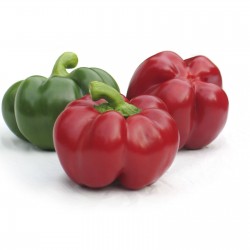
Seminte de ardei dulce -...
Pret
1,85 €
(SKU: PP 67)
Seeds Gallery EU,
5/
5
<div id="idTab1" class="rte">
<h2><strong>Seminte de ardei dulce - Green Rotund</strong></h2>
<h2><span style="color: #ff0000;"><strong>Pret pentru un pachet de 20 de seminte.</strong></span></h2>
<p>Frumos ardei dulce din Bulgaria. Rotund este excelent pentru mâncare proaspătă în salate, murături și gătit. Poate fi uscat și folosit ca pudră de boia de ardei. Acest ardei frumos de moștenire este de o importanță reală în grădină.</p>
<p>Soiul se maturizează devreme. De la germinarea completă a plantelor până la maturitatea tehnică a fructelor este de 108-120 de zile până la biologic - 140-155 de zile. Este o plantă de mărime medie, semi-tulpină, compactă, de 40-60 cm înălțime. Fructele rotunde sunt netede, cu o greutate medie de 150-220 g. La maturitatea industrială fructele sunt verzi, la maturitatea biologică sunt roșu închis. Grosimea peretelui cărnii moale este de aproximativ 8-9 mm.</p>
<p>La maturitatea biologică, fructele conțin 7,0-8,2% bază uscată, 4,2-4,6% zaharoză, 145-198 mg% acid ascorbic.</p>
<p>Se caracterizează prin calitatea ridicată a alimentelor și capacitatea de comercializare. Este rezistent la multe boli. Randamentul este de 40-60 t/ha.</p>
<p>Origine: Bulgaria</p>
</div>
PP 67 (20 S)


Planta rezistenta la frig si inghet
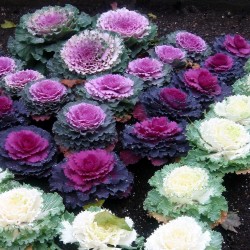
Flowering Kale Seeds...
Pret
1,95 €
(SKU: VE 92)
Seeds Gallery EU,
5/
5
<meta http-equiv="Content-Type" content="text/html; charset=UTF-8" />
<h2><strong>Flowering Kale Seeds Brassica Oleracea</strong></h2>
<h2><span style="color: #ff0000;"><strong>Price for a Package of 25 seeds.</strong></span></h2>
<div>Plant grown for autumn and winter interest. <span style="font-size: 11px; line-height: 1.5em;">Rosettes of cabbage like leaves in white-green, pink, red, and violet-purple. </span><span style="font-size: 11px; line-height: 1.5em;">The colour intensifies as the temperature drops. </span><span style="font-size: 11px; line-height: 1.5em;">Used in containers and for table decoration but also finds use as a winter bedding plant.</span></div>
<div><em><strong>SOWING INSTRUCTIONS</strong></em></div>
<div>Optimum Germination Temp: 15°C</div>
<div>Sowing Depth: 1cm </div>
<div>Sow indoors: March-May</div>
<div>Transplant to Garden: May</div>
<div>Plant spacing: 30cm</div>
<div>Full sun preferred</div>
<div>Flowers: July - November</div>
<div>Mixed Colours</div>
VE 92 (25 S)


Varietate din Grecia
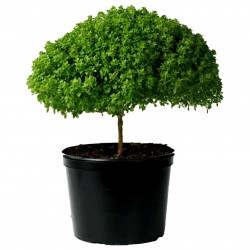
Basil Greek Bascuro seeds...
Pret
1,45 €
(SKU: MHS 97)
Seeds Gallery EU,
5/
5
<h2><strong>Basil Greek Bascuro seeds (Ocimum minimum)</strong></h2>
<h2><span style="color: #ff0000;"><strong>Price for Package of 50 Seeds.</strong></span></h2>
<p>A great basil that has a tiny hummock of a plant, resembling a Lilliputian Oak tree, but redolent with the finest of Basil aroma. Does well in pots, and fits well in pots, even small ones. This type has a bushy habit. The leaves are quite small but the aroma and the flavor are quite large. Very slow to bolt, which is an advantage for home growers but makes it challenging for us to produce seedcrops–we start mighty early! We vote this the best-tasting Basil of all. Traditionally in Greece, a sprig is placed behind the ear to mask unpleasant smells (like tobacco smoke) and attract women (or men).</p>
<p>Easy to grow. Annual.</p>
<p>Family: Mint (Lamiaceae)</p>
<p>Annual, with first harvest at 70 days.</p>
MHS 97 (50 S)


Varietate din Italia
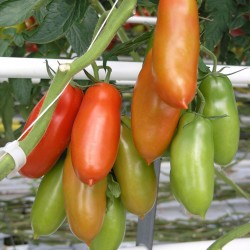
Semințe de roșii San...
Pret
2,85 €
(SKU: VT 166)
Seeds Gallery EU,
5/
5
<h2><strong>Semințe de roșii San Marzano Gigante (Gran Merito).</strong></h2>
<h2><span style="color: #ff0000;"><strong>Preț pentru un pachet de 10 semințe.</strong></span></h2>
<p>Roșia italiană San Marzano Gigante, este cunoscută și sub numele de „Gran Merito”. Frumosele fructe ovale cresc în ciorchini de 6 până la 10 fructe și au în medie 90 până la 120 g în greutate. Se coace la o culoare roșie într-o perioadă de aproximativ 65 până la 75 de zile după însămânțare.</p>
<p>Aceste roșii suculente și delicioase au o durată lungă de valabilitate și sunt folosite în salate și preparate reci, precum și pentru sosuri și preparate gătite.</p>
<p>Plantele puternice au o înălțime medie de 90 până la 100 cm și au un randament excelent. (Determină creșterea)</p>
<p>Roșia San Marzano Gigante nu este hibridă, fără tratament chimic, fără OMG și fără otravă.</p>
VT 166 (10 S)


Varietate din India
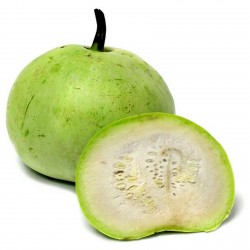
Tinda Seeds, Apple Gourd...
Pret
3,00 €
(SKU: VE 93)
Seeds Gallery EU,
5/
5
<h2><strong>Tinda Seeds, Apple Gourd (Praecitrullus fistulosus)</strong></h2>
<h2><span style="color: #ff0000;"><strong>Price for Package of 3 seeds.</strong></span></h2>
<p>Tinda also called "Indian squash", "round melon", "Indian round gourd" or "apple gourd" or "Indian baby pumpkin", is a squash-like cucurbit grown for its immature fruit, a vegetable especially popular in South Asia.</p>
<p><strong>Distribution and use</strong></p>
<p>The species is native to India and Pakistan and is cultivated in the north of both countries, where the ripe fruits are a popular vegetable. The harvest takes place before the seed husks harden. The fruits are cooked after removing the seeds, often together with lentils. They are also inserted. The seeds are eaten roasted. There are two different forms: one with light green fruits, which is generally preferred, and the other with dark green fruits.</p>
<p>The plant is as with all cucurbits, a prolific vine, and is grown as an annual. The plant also is prickly with small thorns similar to the zucchini. The fruit is approximately spherical, and 5–8 cm in diameter The seeds may also be roasted and eaten. Tinda is a famous nickname among Punjabi families in India. This unique squash-like gourd is native to South Asia, very popular in Indian and Pakistani cooking with curry and many gourmet dishes. Green colored, apple-sized fruits are flattish round in shape and 50–60 grams in weight. Plants are vigorous, productive and begin to bear fruits in 70 days after planting.</p>
<p>Tinda can be confused with tendli or kundru due to similar-sounding names from different languages and regions. Tinda in Punjabi or most North Indian languages are "Indian baby pumpkin".</p>
<p>Tinda is considered a boring vegetable by many in North India – part of the reason is it is used in a lot of curries during high season and tastes bland unless used with a lot of spices. Further, its seeds are not favored by many. It is practically unknown in South India.</p>
VE 93 (3 S)


Varietate din Serbia

Planta rezistenta la frig si inghet
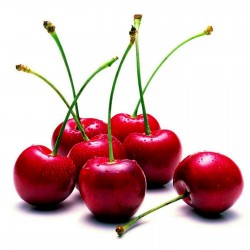
Serbian sweet dwarf Morello...
Pret
1,95 €
(SKU: V 216)
Seeds Gallery EU,
5/
5
<h2><strong>Serbian morello cherry seeds (Prunus cerasus)</strong></h2>
<h2 class=""><span style="color: #ff0000;"><strong>Price for Package of 10 (2,5g) seeds.</strong></span></h2>
<p>This cherry variety originally comes from Serbia and is over 120 years old. The fruits are extremely large (almost as big as cherries), dark-red in color, and very sweet. The tree reaches a height of approx. 4 meters and a diameter of approx. 2 to 3 meters. The variety is extremely fertile and can deliver over 50 kilograms of cherries in season.</p>
<p>This variety withstood temperatures of - 30 degrees Celsius. However, it is believed that it can easily withstand -40 an more degrees Celsius. It is resistant to diseases and there is no need to use chemical preparations.</p>
<h3><strong>You can read more about cherries on Wikipedia:</strong></h3>
<p><i><b>Prunus cerasus</b></i><span> </span>(<b>sour<span> </span>cherry</b>,<sup id="cite_ref-3" class="reference">[3]</sup><span> </span><b>tart cherry</b>, or<span> </span><b>dwarf cherry</b><sup id="cite_ref-BSBI07_4-0" class="reference">[4]</sup>) is a species of<span> </span><i>Prunus</i><span> </span>in the subgenus<span> </span><i>Cerasus</i><span> </span>(cherries), native to much of<span> </span>Europe<span> </span>and southwest<span> </span>Asia. It is closely related to the sweet cherry (<i>Prunus avium</i>), but has a<span> </span>fruit<span> </span>that is more<span> </span>acidic. Its sour pulp is edible.<sup id="cite_ref-5" class="reference">[5]</sup></p>
<p>The tree is smaller than the sweet cherry (growing to a height of 4–10 m), has twiggy branches, and its crimson-to-near-black cherries are borne upon shorter stalks.<sup class="noprint Inline-Template Template-Fact">[<i><span title="This claim needs references to reliable sources. (December 2013)">citation needed</span></i>]</sup><span> </span>There are two main varieties (groups of<span> </span>cultivars) of the<span> </span><b>sour cherry</b>: the dark-red<span> </span><b>morello cherry</b><span> </span>and the lighter-red<span> </span><b>amarelle cherry</b>.</p>
<h2><span class="mw-headline" id="Origins_and_cultivation">Origins and cultivation</span></h2>
<div class="thumb tright">
<div class="thumbinner"><img alt="Serbian morello cherry seeds (Prunus cerasus)" src="https://upload.wikimedia.org/wikipedia/commons/thumb/e/e4/Illustration_Prunus_cerasus0.jpg/220px-Illustration_Prunus_cerasus0.jpg" decoding="async" width="220" height="359" class="thumbimage" srcset="//upload.wikimedia.org/wikipedia/commons/thumb/e/e4/Illustration_Prunus_cerasus0.jpg/330px-Illustration_Prunus_cerasus0.jpg 1.5x, //upload.wikimedia.org/wikipedia/commons/thumb/e/e4/Illustration_Prunus_cerasus0.jpg/440px-Illustration_Prunus_cerasus0.jpg 2x" data-file-width="1462" data-file-height="2388" title="Serbian morello cherry seeds (Prunus cerasus)" />
<div class="thumbcaption">
<div class="magnify"></div>
Illustration of Morello Cherry</div>
</div>
</div>
<p><i>Prunus cerasus</i>, a<span> </span>tetraploid<span> </span>with 2n=32 chromosomes, is thought to have originated as a natural hybrid between<span> </span><i>Prunus avium</i><span> </span>and<span> </span><i>Prunus fruticosa</i><span> </span>in the<span> </span>Iranian Plateau<span> </span>or Eastern Europe where the two species come into contact.<span> </span><i>Prunus fruticosa</i><span> </span>is believed to have provided its smaller size and sour tasting fruit. The hybrids then stabilised and interbred to form a new, distinct species.<sup id="cite_ref-7" class="reference">[7]</sup></p>
<p>Cultivated sour cherries were selected from wild specimens of<span> </span><i>Prunus cerasus</i><span> </span>and the doubtfully distinct<span> </span><i>P. acida</i><span> </span>from around the<span> </span>Caspian<span> </span>and<span> </span>Black Seas, and were known to the<span> </span>Greeks<span> </span>in 300 BC. They were also extremely popular with<span> </span>Persians<span> </span>and the<span> </span>Romans<span> </span>who introduced them into<span> </span>Britain<span> </span>long before the 1st century AD. The fruit remains popular in modern-day<span> </span>Iran.</p>
<p>In England, their cultivation was popularised in the 16th century in the time of<span> </span>Henry VIII. They became a popular crop amongst Kentish growers, and by 1640 over two dozen named<span> </span>cultivars<span> </span>were recorded. In the Americas, by 1704 the Vestry of<span> </span>New Kent County, Virginia<span> </span>recorded "The DePriest of Kent" planted 354 acres of Prunus cerasus along the<span> </span>Pamunkey River<span> </span>as the 'Kent' variety, that spawned other<span> </span>Virginia<span> </span>colonists throughout Richmond to plant sour cherry trees, 'Early Richmond' variety or 'Kentish Red', when they arrived.<sup id="cite_ref-8" class="reference">[8]</sup></p>
<div class="thumb tright">
<div class="thumbinner"><img alt="Serbian morello cherry seeds (Prunus cerasus)" src="https://upload.wikimedia.org/wikipedia/commons/thumb/5/57/Fr%C3%BChling_bl%C3%BChender_Kirschenbaum.jpg/220px-Fr%C3%BChling_bl%C3%BChender_Kirschenbaum.jpg" decoding="async" width="220" height="166" class="thumbimage" srcset="//upload.wikimedia.org/wikipedia/commons/thumb/5/57/Fr%C3%BChling_bl%C3%BChender_Kirschenbaum.jpg/330px-Fr%C3%BChling_bl%C3%BChender_Kirschenbaum.jpg 1.5x, //upload.wikimedia.org/wikipedia/commons/thumb/5/57/Fr%C3%BChling_bl%C3%BChender_Kirschenbaum.jpg/440px-Fr%C3%BChling_bl%C3%BChender_Kirschenbaum.jpg 2x" data-file-width="2272" data-file-height="1712" title="Serbian morello cherry seeds (Prunus cerasus)" />
<div class="thumbcaption">
<div class="magnify"></div>
A blooming sour cherry tree</div>
</div>
</div>
<p>Before the<span> </span>Second World War<span> </span>there were more than fifty cultivars of sour cherry in cultivation in England; today, however, few are grown commercially, and despite the continuation of named cultivars such as 'Kentish Red', 'Amarelles', 'Griottes' and 'Flemish', only the generic Morello is offered by most nurseries. This is a late-flowering variety, and thus misses more frosts than its sweet counterpart and is therefore a more reliable cropper. The Morello cherry ripens in mid to late summer, toward the end of August in southern England. It is self-fertile, and would be a good<span> </span>pollenizer<span> </span>for other varieties if it did not flower so late in the season.</p>
<div class="thumb tright">
<div class="thumbinner"><img alt="Serbian morello cherry seeds (Prunus cerasus)" src="https://upload.wikimedia.org/wikipedia/commons/thumb/b/bc/SourcherryYield.png/220px-SourcherryYield.png" decoding="async" width="220" height="132" class="thumbimage" srcset="//upload.wikimedia.org/wikipedia/commons/thumb/b/bc/SourcherryYield.png/330px-SourcherryYield.png 1.5x, //upload.wikimedia.org/wikipedia/commons/thumb/b/bc/SourcherryYield.png/440px-SourcherryYield.png 2x" data-file-width="1600" data-file-height="960" title="Serbian morello cherry seeds (Prunus cerasus)" />
<div class="thumbcaption">
<div class="magnify"></div>
Worldwide sour cherry production</div>
</div>
</div>
<p>Sour cherries require similar cultivation conditions to<span> </span>pears, that is, they prefer a rich, well-drained, moist<span> </span>soil, although they demand more<span> </span>nitrogen<span> </span>and<span> </span>water<span> </span>than sweet cherries. Trees will do badly if waterlogged, but have greater tolerance of poor drainage than sweet varieties. As with sweet cherries, Morellos are traditionally cultivated by budding onto strong growing rootstocks, which produce trees too large for most gardens, although newer dwarfing rootstocks such as<span> </span><i>Colt</i><span> </span>and<span> </span><i>Gisella</i><span> </span>are now available. During spring, flowers should be protected, and trees weeded, mulched and sprayed with natural seaweed solution. This is also the time when any required<span> </span>pruning<span> </span>should be carried out (note that cherries should not be pruned during the dormant winter months). Morello cherry trees fruit on younger wood than sweet varieties, and thus can be pruned harder. They are usually grown as standards, but can be fan trained, cropping well even on cold walls, or grown as low bushes.<sup id="cite_ref-9" class="reference">[9]</sup></p>
<div class="thumb tright">
<div class="thumbinner"><img alt="Serbian morello cherry seeds (Prunus cerasus)" src="https://upload.wikimedia.org/wikipedia/commons/thumb/9/9f/Ripe_sour_cherries_on_a_branch.jpg/220px-Ripe_sour_cherries_on_a_branch.jpg" decoding="async" width="220" height="161" class="thumbimage" srcset="//upload.wikimedia.org/wikipedia/commons/thumb/9/9f/Ripe_sour_cherries_on_a_branch.jpg/330px-Ripe_sour_cherries_on_a_branch.jpg 1.5x, //upload.wikimedia.org/wikipedia/commons/9/9f/Ripe_sour_cherries_on_a_branch.jpg 2x" data-file-width="430" data-file-height="314" title="Serbian morello cherry seeds (Prunus cerasus)" />
<div class="thumbcaption">
<div class="magnify"></div>
Ripe sour cherries (Somogy,<span> </span>Hungary)</div>
</div>
</div>
<div class="thumb tright">
<div class="thumbinner"><img alt="Serbian morello cherry seeds (Prunus cerasus)" src="https://upload.wikimedia.org/wikipedia/commons/thumb/9/94/Black_Che.jpg/220px-Black_Che.jpg" decoding="async" width="220" height="163" class="thumbimage" srcset="//upload.wikimedia.org/wikipedia/commons/thumb/9/94/Black_Che.jpg/330px-Black_Che.jpg 1.5x, //upload.wikimedia.org/wikipedia/commons/thumb/9/94/Black_Che.jpg/440px-Black_Che.jpg 2x" data-file-width="2944" data-file-height="2184" title="Serbian morello cherry seeds (Prunus cerasus)" />
<div class="thumbcaption">
<div class="magnify"></div>
Ripe sour cherries and their leaves (Karaj,<span> </span>Iran)</div>
</div>
</div>
<div class="thumb tright">
<div class="thumbinner"><img alt="Serbian morello cherry seeds (Prunus cerasus)" src="https://upload.wikimedia.org/wikipedia/commons/thumb/a/a6/Owoce_Wi%C5%9Bnia.jpg/220px-Owoce_Wi%C5%9Bnia.jpg" decoding="async" width="220" height="220" class="thumbimage" srcset="//upload.wikimedia.org/wikipedia/commons/thumb/a/a6/Owoce_Wi%C5%9Bnia.jpg/330px-Owoce_Wi%C5%9Bnia.jpg 1.5x, //upload.wikimedia.org/wikipedia/commons/thumb/a/a6/Owoce_Wi%C5%9Bnia.jpg/440px-Owoce_Wi%C5%9Bnia.jpg 2x" data-file-width="1024" data-file-height="1024" title="Serbian morello cherry seeds (Prunus cerasus)" />
<div class="thumbcaption">
<div class="magnify"></div>
A sour cherry Beauty Sheet</div>
</div>
</div>
<p>Sour cherries suffer fewer pests and diseases than sweet cherries, although they are prone to heavy fruit losses from<span> </span>birds. In summer, fruit should be protected with netting. When harvesting fruit, they should be cut from the tree rather than risking damage by pulling the stalks.</p>
<p>Unlike most sweet cherry varieties, sour cherries are<span> </span>self fertile<span> </span>or self<span> </span>pollenizing<span> </span>(sometimes inaccurately referred to as<span> </span>self-pollinating). Two implications of this are that seeds generally run true to the cultivar, and that much smaller<span> </span>pollinator<span> </span>populations are needed because<span> </span>pollen<span> </span>only has to be moved within individual flowers. In areas where pollinators are scarce, growers find that<span> </span>stocking beehives<span> </span>in orchards improves yields.<sup id="cite_ref-10" class="reference">[10]</sup></p>
<p>Some cultivars of sour cherry trees, such as Montmorency and<span> </span>North Star, have been documented to perform better than other cherry trees in Colorado's<span> </span>Front Range<span> </span>region.<sup id="cite_ref-11" class="reference">[11]</sup><sup id="cite_ref-12" class="reference">[12]</sup></p>
<table class="wikitable">
<tbody>
<tr>
<th colspan="5">Top 10 sour cherry producers in 2012</th>
</tr>
<tr>
<th>Country</th>
<th>Production (tonnes)</th>
<th>Footnote</th>
</tr>
<tr>
<td align="left"><span class="flagicon"><img alt="" src="https://upload.wikimedia.org/wikipedia/commons/thumb/b/b4/Flag_of_Turkey.svg/23px-Flag_of_Turkey.svg.png" decoding="async" width="23" height="15" class="thumbborder" srcset="//upload.wikimedia.org/wikipedia/commons/thumb/b/b4/Flag_of_Turkey.svg/35px-Flag_of_Turkey.svg.png 1.5x, //upload.wikimedia.org/wikipedia/commons/thumb/b/b4/Flag_of_Turkey.svg/45px-Flag_of_Turkey.svg.png 2x" data-file-width="1200" data-file-height="800" /> </span>Turkey</td>
<td>187,941</td>
<td></td>
</tr>
<tr>
<td align="left"><span class="flagicon"><img alt="" src="https://upload.wikimedia.org/wikipedia/en/thumb/f/f3/Flag_of_Russia.svg/23px-Flag_of_Russia.svg.png" decoding="async" width="23" height="15" class="thumbborder" srcset="//upload.wikimedia.org/wikipedia/en/thumb/f/f3/Flag_of_Russia.svg/35px-Flag_of_Russia.svg.png 1.5x, //upload.wikimedia.org/wikipedia/en/thumb/f/f3/Flag_of_Russia.svg/45px-Flag_of_Russia.svg.png 2x" data-file-width="900" data-file-height="600" /> </span>Russia</td>
<td>183,300</td>
<td>*</td>
</tr>
<tr>
<td align="left"><span class="flagicon"><img alt="" src="https://upload.wikimedia.org/wikipedia/en/thumb/1/12/Flag_of_Poland.svg/23px-Flag_of_Poland.svg.png" decoding="async" width="23" height="14" class="thumbborder" srcset="//upload.wikimedia.org/wikipedia/en/thumb/1/12/Flag_of_Poland.svg/35px-Flag_of_Poland.svg.png 1.5x, //upload.wikimedia.org/wikipedia/en/thumb/1/12/Flag_of_Poland.svg/46px-Flag_of_Poland.svg.png 2x" data-file-width="1280" data-file-height="800" /> </span>Poland</td>
<td>175,391</td>
<td></td>
</tr>
<tr>
<td align="left"><span class="flagicon"><img alt="" src="https://upload.wikimedia.org/wikipedia/commons/thumb/4/49/Flag_of_Ukraine.svg/23px-Flag_of_Ukraine.svg.png" decoding="async" width="23" height="15" class="thumbborder" srcset="//upload.wikimedia.org/wikipedia/commons/thumb/4/49/Flag_of_Ukraine.svg/35px-Flag_of_Ukraine.svg.png 1.5x, //upload.wikimedia.org/wikipedia/commons/thumb/4/49/Flag_of_Ukraine.svg/45px-Flag_of_Ukraine.svg.png 2x" data-file-width="1200" data-file-height="800" /> </span>Ukraine</td>
<td>172,800</td>
<td></td>
</tr>
<tr>
<td align="left"><span class="flagicon"><img alt="" src="https://upload.wikimedia.org/wikipedia/commons/thumb/c/ca/Flag_of_Iran.svg/23px-Flag_of_Iran.svg.png" decoding="async" width="23" height="13" class="thumbborder" srcset="//upload.wikimedia.org/wikipedia/commons/thumb/c/ca/Flag_of_Iran.svg/35px-Flag_of_Iran.svg.png 1.5x, //upload.wikimedia.org/wikipedia/commons/thumb/c/ca/Flag_of_Iran.svg/46px-Flag_of_Iran.svg.png 2x" data-file-width="630" data-file-height="360" /> </span>Iran</td>
<td>105,000</td>
<td>F</td>
</tr>
<tr>
<td align="left"><span class="flagicon"><img alt="" src="https://upload.wikimedia.org/wikipedia/commons/thumb/f/ff/Flag_of_Serbia.svg/23px-Flag_of_Serbia.svg.png" decoding="async" width="23" height="15" class="thumbborder" srcset="//upload.wikimedia.org/wikipedia/commons/thumb/f/ff/Flag_of_Serbia.svg/35px-Flag_of_Serbia.svg.png 1.5x, //upload.wikimedia.org/wikipedia/commons/thumb/f/ff/Flag_of_Serbia.svg/45px-Flag_of_Serbia.svg.png 2x" data-file-width="945" data-file-height="630" /> </span>Serbia</td>
<td>74,656</td>
<td></td>
</tr>
<tr>
<td align="left"><span class="flagicon"><img alt="" src="https://upload.wikimedia.org/wikipedia/commons/thumb/c/c1/Flag_of_Hungary.svg/23px-Flag_of_Hungary.svg.png" decoding="async" width="23" height="12" class="thumbborder" srcset="//upload.wikimedia.org/wikipedia/commons/thumb/c/c1/Flag_of_Hungary.svg/35px-Flag_of_Hungary.svg.png 1.5x, //upload.wikimedia.org/wikipedia/commons/thumb/c/c1/Flag_of_Hungary.svg/46px-Flag_of_Hungary.svg.png 2x" data-file-width="1200" data-file-height="600" /> </span>Hungary</td>
<td>53,425</td>
<td></td>
</tr>
<tr>
<td align="left"><span class="flagicon"><img alt="" src="https://upload.wikimedia.org/wikipedia/en/thumb/a/a4/Flag_of_the_United_States.svg/23px-Flag_of_the_United_States.svg.png" decoding="async" width="23" height="12" class="thumbborder" srcset="//upload.wikimedia.org/wikipedia/en/thumb/a/a4/Flag_of_the_United_States.svg/35px-Flag_of_the_United_States.svg.png 1.5x, //upload.wikimedia.org/wikipedia/en/thumb/a/a4/Flag_of_the_United_States.svg/46px-Flag_of_the_United_States.svg.png 2x" data-file-width="1235" data-file-height="650" /> </span>United States</td>
<td>38,601</td>
<td></td>
</tr>
<tr>
<td align="left"><span class="flagicon"><img alt="" src="https://upload.wikimedia.org/wikipedia/commons/thumb/8/84/Flag_of_Uzbekistan.svg/23px-Flag_of_Uzbekistan.svg.png" decoding="async" width="23" height="12" class="thumbborder" srcset="//upload.wikimedia.org/wikipedia/commons/thumb/8/84/Flag_of_Uzbekistan.svg/35px-Flag_of_Uzbekistan.svg.png 1.5x, //upload.wikimedia.org/wikipedia/commons/thumb/8/84/Flag_of_Uzbekistan.svg/46px-Flag_of_Uzbekistan.svg.png 2x" data-file-width="1000" data-file-height="500" /> </span>Uzbekistan</td>
<td>34,000</td>
<td>F</td>
</tr>
<tr>
<td align="left"><span class="flagicon"><img alt="" src="https://upload.wikimedia.org/wikipedia/commons/thumb/d/dd/Flag_of_Azerbaijan.svg/23px-Flag_of_Azerbaijan.svg.png" decoding="async" width="23" height="12" class="thumbborder" srcset="//upload.wikimedia.org/wikipedia/commons/thumb/d/dd/Flag_of_Azerbaijan.svg/35px-Flag_of_Azerbaijan.svg.png 1.5x, //upload.wikimedia.org/wikipedia/commons/thumb/d/dd/Flag_of_Azerbaijan.svg/46px-Flag_of_Azerbaijan.svg.png 2x" data-file-width="1200" data-file-height="600" /> </span>Azerbaijan</td>
<td>23,085</td>
<td></td>
</tr>
<tr>
<th>World</th>
<th>1,149,531</th>
<th>A</th>
</tr>
<tr>
<td colspan="5">* = Unofficial figure | [ ] = Official data | A = May include official, semi-official or estimated data<br />F = FAO estimate | Im = FAO data based on imputation methodology | M = Data not available<br />
<p><i>Source:<span> </span>UN Food and Agriculture Organization<span> </span>(FAO)</i><sup id="cite_ref-13" class="reference">[13]</sup></p>
</td>
</tr>
</tbody>
</table>
<h2><span class="mw-headline" id="Uses">Uses</span></h2>
<div class="thumb tright">
<div class="thumbinner"><img alt="" src="https://upload.wikimedia.org/wikipedia/commons/thumb/6/60/Kriek_Beer_1.jpg/220px-Kriek_Beer_1.jpg" decoding="async" width="220" height="302" class="thumbimage" srcset="//upload.wikimedia.org/wikipedia/commons/thumb/6/60/Kriek_Beer_1.jpg/330px-Kriek_Beer_1.jpg 1.5x, //upload.wikimedia.org/wikipedia/commons/thumb/6/60/Kriek_Beer_1.jpg/440px-Kriek_Beer_1.jpg 2x" data-file-width="1104" data-file-height="1517" />
<div class="thumbcaption">
<div class="magnify"></div>
Kriek lambic<span> </span>is infused with sour cherries</div>
</div>
</div>
<h3><span class="mw-headline" id="Culinary">Culinary</span></h3>
<p>Dried sour cherries are used in cooking including<span> </span>soups,<span> </span>pork<span> </span>dishes,<span> </span>cakes,<span> </span>tarts, and<span> </span>pies.</p>
<p>Sour cherries or sour cherry<span> </span>syrup<span> </span>are used in<span> </span>liqueurs<span> </span>and<span> </span>drinks, such as the portuguese<span> </span>ginjinha. In<span> </span>Iran,<span> </span>Turkey,<span> </span>Greece<span> </span>and<span> </span>Cyprus, sour cherries are especially prized for making<span> </span>spoon sweets<span> </span>by slowly boiling pitted sour cherries and sugar; the syrup thereof is used for<span> </span><i>sharbat-e Albalou</i>,<span> </span><i>vişne şurubu</i><span> </span>or<span> </span><i>vyssináda</i>, a beverage made by diluting the syrup with ice-cold water. A particular use of sour cherries is in the production of<span> </span>kriek lambic, a cherry-flavored variety of a naturally<span> </span>fermented<span> </span>beer<span> </span>made in Belgium.</p>
<script src="//cdn.public.n1ed.com/G3OMDFLT/widgets.js"></script>
V 216 (10 S)







